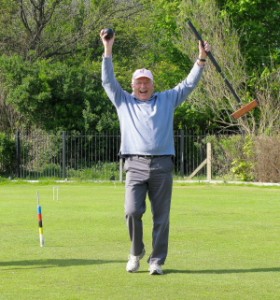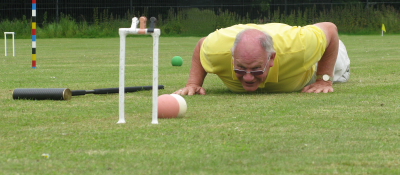S HARP SHOOTING CROQUET WITH YOUR CAMERA
HARP SHOOTING CROQUET WITH YOUR CAMERA
N ew camera for Xmas? Decent camera on your mobile phone? Photography has never been so popular, yet most images are never printed – just stored and viewed on computers, mobile phones, and social media networks such as Facebook or Flickr.. Why not consider sending your pictures to the website? Whilst the webmaster loves to receive high resolution images with excellent colour balance, this is the real world where fancy cameras are not the norm at your average croquet tournament. Whilst that image may look good on your small LCD screen (it is designed that way), once it is transmitted, cropped and enlarged it can start to look a poor specimen of its former glory. However, with a little planning almost any camera can record an image that the webmaster may be able to use in some form or other.
ew camera for Xmas? Decent camera on your mobile phone? Photography has never been so popular, yet most images are never printed – just stored and viewed on computers, mobile phones, and social media networks such as Facebook or Flickr.. Why not consider sending your pictures to the website? Whilst the webmaster loves to receive high resolution images with excellent colour balance, this is the real world where fancy cameras are not the norm at your average croquet tournament. Whilst that image may look good on your small LCD screen (it is designed that way), once it is transmitted, cropped and enlarged it can start to look a poor specimen of its former glory. However, with a little planning almost any camera can record an image that the webmaster may be able to use in some form or other.
Surprisingly, Croquet is not an easy subject to photograph. Yes, there are opportunities for group shots, presentations, or passport type mug shots, but important as these are for the usual reports, the website also needs a wider range to keep content dynamic. Not only does your website need images, but your local media (Newspaper, and local internet news services) will gratefully take reasonable quality pictures from you and so provide your club with regular free publicity. It is worth getting to know their deadline times and make sure your offering reaches them before they go to print.
 So what is stopping you?
So what is stopping you?
Basic rules are commonsense – before you press that shutter button – ask yourself what are you photographing? The tournament winner with trophy? – so give us head, shoulders and trophy, obviously with look of pride and eyes looking into camera. No distracting background, no messy tables, no flagpoles sticking out of head, avoid the sky if possible and use any autofocus mechanism your device has. Check shot for sharpness, no squinty eyes, then take another one for luck – job done. If your device has built in flash try switching it on (yes, even in daylight!) and see how it adds that extra ‘pop’ to your picture. If your subject is in shadow, most definitely switch on your flash. Don’t worry about exposure, the clever algorithms in modern cameras take care of most situations.
 Don’t bother editing the picture, the webmaster can customise it to suit the website – just email the file, adding details of tournament, winner and any information about the event, commenting on the Who, Why, When, Where and So What? Remember your digital images are made up of thousands of pixels – the more the better, trouble is that if you crop the image, you throw away some of these pixels; worse if you attempt any adjustment to your image (eg changing brightness) when you re-save the image then more pixels are thrown away. Each time you re-save an image this throw away process repeats – it’s the way it works! So always save a copy of your original image and only adjust a copy of it. Send the webmaster a copy of the original image since this gives maximum flexibility for the website.
Don’t bother editing the picture, the webmaster can customise it to suit the website – just email the file, adding details of tournament, winner and any information about the event, commenting on the Who, Why, When, Where and So What? Remember your digital images are made up of thousands of pixels – the more the better, trouble is that if you crop the image, you throw away some of these pixels; worse if you attempt any adjustment to your image (eg changing brightness) when you re-save the image then more pixels are thrown away. Each time you re-save an image this throw away process repeats – it’s the way it works! So always save a copy of your original image and only adjust a copy of it. Send the webmaster a copy of the original image since this gives maximum flexibility for the website.
Then there is the group shot – is a formal or casual shot required? Speed is of the essence here, nobody wants to stand around in the rain and wind waiting for the photographer to sort themselves out. If it is the formal shot, agree with the supremo when you can do the shot, then decide your background and put chairs or other props in place. You can then direct people into their places, tell them how to sit, stand, fold arms, hold equipment, or whatever, smile at camera and bingo. Another one for luck and everyone gets on with their day. Sharpness is essential, if you have a focussing guide – flashing light or green box – be patient and use it – it may feel like taking ages but in reality it is only a few seconds. For the informal groups, your subjects have often arranged themselves into their comfort zones, all you have to do is a quick check for background distractions, perhaps a quick exchange of places to make a visually more attractive pattern of heights, tell them how to look (are sunglasses attractive?) and click – another one in the can. Incidentally, if anyone is wearing a hat, ask them to tilt it back slightly – just avoids dark shadows in faces.
 Now we need some dynamic shots. Since you play the game you will know that running around the lawn perimeter chasing the action is not a good idea; neither is walking across the line of sight of a player and using your flashgun will definitely not make you the most popular spectator! Croquet (like Fishing) is not a magnet for Sports photographers – too much hanging around to capture that unpredictable ‘special moment’! – but you have the added advantage that as a player you will know when these moments are most likely to occur. So take a chair and sit somewhere unobtrusively where you get a good view of several lawns and put your lens on its longest focal length.
Now we need some dynamic shots. Since you play the game you will know that running around the lawn perimeter chasing the action is not a good idea; neither is walking across the line of sight of a player and using your flashgun will definitely not make you the most popular spectator! Croquet (like Fishing) is not a magnet for Sports photographers – too much hanging around to capture that unpredictable ‘special moment’! – but you have the added advantage that as a player you will know when these moments are most likely to occur. So take a chair and sit somewhere unobtrusively where you get a good view of several lawns and put your lens on its longest focal length.
If you can control your camera settings, try 1/500 sec at f8 at ISO 200 and you will not be far away. Adjust the ISO number to fine tune. Obviously fancy cameras gives you lots more options and advantages but we are talking here of popular prosumer cameras. The most common detraction in photography is Camera Shake, not the result of excessive drinking, it’s just that cameras are so lightweight just pressing the shutter button causes the camera to move slightly as the shutter opens, resulting in blurred looking pictures. The solution is a small tripod (if possible) or a shorter shutter speed, but failing that, keep your elbows pressed into your side to support the camera and better still, rest your camera on something solid – a fence post is ideal – and squeeze the shutter button gently.
 Some players have characteristic actions for certain shots (you know when these are about to occur) and you can also spot those concentrated moments – lying down, bending, kneeling, hammer shots, etc. all make for different pictures. Referees ‘in action’ can surprisingly give you unusual images. Don’t forget the moment of pegging out, especially a tournament winning moment – unique moments in time and the position on the lawn can be planned for – it will always be near the peg!
Some players have characteristic actions for certain shots (you know when these are about to occur) and you can also spot those concentrated moments – lying down, bending, kneeling, hammer shots, etc. all make for different pictures. Referees ‘in action’ can surprisingly give you unusual images. Don’t forget the moment of pegging out, especially a tournament winning moment – unique moments in time and the position on the lawn can be planned for – it will always be near the peg!
There are zillions of pictures of players running hoops or striking yet another ball, so if you wish to add to this library, try and get the players face in the picture, at least let us recognise them – a low viewpoint is useful.
 We all like a nice blue sky but too often we get the grey variety – not good in pictures, ends up looking washed out, since its brightness fools your automatic exposure system. So avoid the sky unless it contains an interesting rainbow, bird or even the red arrows. Similarly indoors, it is not the sky which causes problems but the fluorescent or tungsten lighting producing all kinds of strange colours in your image – so flash is a definite here. If you are too close to your subject place a white tissue over the flash to diffuse the light.
We all like a nice blue sky but too often we get the grey variety – not good in pictures, ends up looking washed out, since its brightness fools your automatic exposure system. So avoid the sky unless it contains an interesting rainbow, bird or even the red arrows. Similarly indoors, it is not the sky which causes problems but the fluorescent or tungsten lighting producing all kinds of strange colours in your image – so flash is a definite here. If you are too close to your subject place a white tissue over the flash to diffuse the light.
Any decent compact camera is capable of producing images that are capable of being re-produced on the website. Why not give it a go? It is very satisfying to see your work published for the world to admire.
Happy shooting.
Tony Thomas is webmaster of www.www.croquetnw.co.uk

I’ve been surfing online more than 4 hours today, yet I never found any interesting article like yours. It is pretty worth enough for me. In my opinion, if all site owners and bloggers made good content as you did, the internet will be much more useful than ever before.